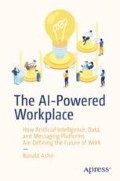Abstract
Artificial intelligence (AI) is notoriously hard to define, and this has been both a boon and a curse. The broadness of the term has allowed for a very wide and disparate set of techniques to inhabit the same space, from data-intensive machine learning techniques such as neural networks to model-based deduction logics, and from the incorporation of techniques from statistics to the use of psychological models of the mind. At the same time, all these attempts to emulate existing forms of intelligence or create new ones has allowed for debates to flourish about what is actual intelligence. While in some contexts these debates are useful, they can also be distracting and confusing. They can lead people to set expectations or express concerns about AI that are not founded in what the technology is currently capable of or what we can confidently say it will be capable of, but rather extrapolations that are based more on beliefs and hunches.
Access this chapter
Tax calculation will be finalised at checkout
Purchases are for personal use only
Notes
- 1.
Note that I said “feels like it might threaten it.” There is an intense debate about the risks AI poses to humanity from an existential point of view. That is one debate that this book will not try to tackle. However, I do urge everyone to consider the near-term risks stemming from the misuse of current day technology (a risk I consider urgent and present), as well as investigate carefully if there are any real long-term risks from sentient software taking over (risks I consider more of a thought exercise than, in any form, real).
- 2.
Nick Bostrom and Eliezer Yudkowsky, “The Ethics of Artificial Intelligence” in The Cambridge Handbook of Artificial Intelligence (Cambridge, UK: Cambridge University Press, 2014) pp. 316–334.
- 3.
Stuart Russel and Peter Norvig, Artificial Intelligence: A Modern Approach (Pearson, 2010).
- 4.
Michael Luck and Mark d’Inverno, “A Formal Framework for Agency and Autonomy” in Proceedings of the First International Conference on Multi-Agent Systems, eds. Victor Lesser and Les Gasser (Cambridge, MA: MIT Press, 1995) pp. 254–260.
- 5.
Unless you are looking to raise VC money, that is!
Author information
Authors and Affiliations
Rights and permissions
Copyright information
© 2020 Ronald Ashri
About this chapter
Cite this chapter
Ashri, R. (2020). What Is AI?. In: The AI-Powered Workplace. Apress, Berkeley, CA. https://doi.org/10.1007/978-1-4842-5476-9_2
Download citation
DOI: https://doi.org/10.1007/978-1-4842-5476-9_2
Published:
Publisher Name: Apress, Berkeley, CA
Print ISBN: 978-1-4842-5475-2
Online ISBN: 978-1-4842-5476-9
eBook Packages: Professional and Applied ComputingApress Access BooksProfessional and Applied Computing (R0)

